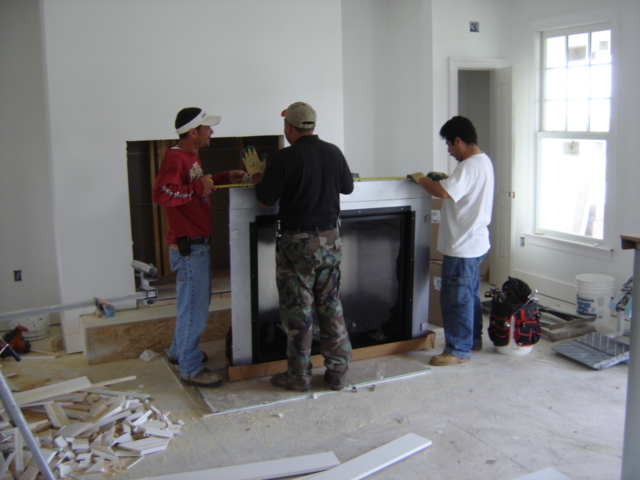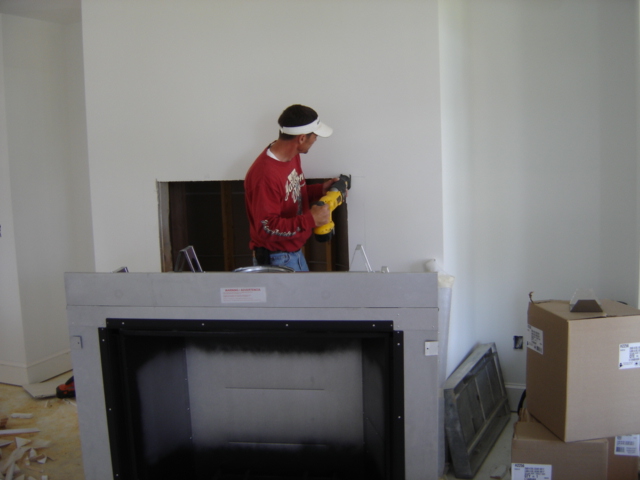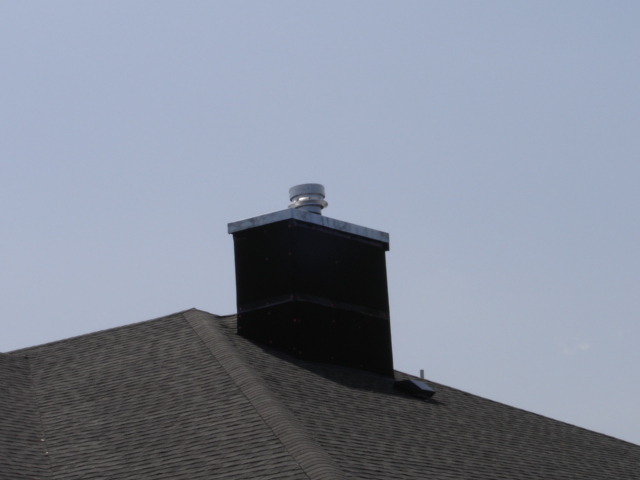Building our new house:
Fireplace and chimney
We are installing a gas fireplace in the house. Here are photos of that installation.
UPDATE: Scroll to the bottom of the page to see the rest of the story as of 16 may 2008.
The hole that we had cut into the wall was not quite big enough for the fireplace -- this thing is huge -- may be too big -- but here it is. In this photo, Chris, our builder, is talking with the two fireplace installers about measurements.
After we determined that the hole was too small for the fireplace, Chris pulled out a reciprocating saw ("Sawzall") and re-sized the hole -- very delicately, of course.
No photos of the finished fireplace yet, but, here's the chimney.
In this photo you see the stainless steel flue-chimney, the galvanized chimney cap, and the chimney wrapped in ice shield. Later we will install stone around the chimney.
Also -- we plan to install an English-style chimney pot to conceal the somewhat ugly steel flue. Here's a link to a site that sells terra cotta and ceramic chimney pots so you can see what we will install -- and here's a link to a place that specializes in copper chimney pots.
UPDATE: Big change in the fireplace.
As you can see in the photos, this fireplace is huge. As of 16 May, we are removing this monster and replacing it with a gas fireplace that is more in proportion with the room. Here are the details.
We wanted to install a wood-burning fireplace and put gas logs inside the fireplace. We ordered a wood-burning fireplace and a set of gas logs. However -- because of the hip roof on the house, the chimney is in the center of the house -- the fireplace is not in the center. Thus, the chimney flue must go up from the fireplace, make a 45-degree turn, travel a short distance, then make another 45-degree turn to go out the chimney.
A wood-burning fireplace cannot have a flue with turns in it -- because -- wood smoke contains particles that, when they cool, deposit onto the sides of the flue. This is why, with a wood-burning fireplace, you need to have a chimney sweep clean the chimney every couple of years.
When the wood-burning fireplace was delivered, the installers told us they could not install it. They pulled out some brochures and told us to select another fireplace. We were not really clear about what we were looking at and we ended up selecting the biggest and most expensive fireplace they had. When it arrived we were astounded at the size. We installed it but the more we looked at it, the more we realized it had to come out -- it was far too big for the room.
When we told the supplier this, he did not want to remove the fireplace. Finally, after 3-4 days of back and forth, Joe firmly told the supplier to come get the fireplace, flue, and everything else they installed, period. He then told our builder that he would remove everything and we could go somewhere else for a fireplace. We did.
The fireplace we are now installing is coming from Noblett's Appliance and Propane, Kilmarnock, VA -- we should have gone to them in the first place. Mr. William Dunaway of Noblett's sat down with us and explained all about the types of gas fireplaces and showed us the products they sell. We are now installing a:
- Keystone Deluxe 36, B-vent fireplace.
- Mission louvers in hammered pewter.
- Bi-fold glass doors with matte black trim.
- Aged brick fire liner.
- Remote control.
Here's a primer on gas fireplaces
Gas fireplaces come in three types:
- Ventless
- Direct vent
- B-vent
Ventless -- exactly what is says. This fireplace has no chimney, no vent to the outside -- you can install a vent for fresh air to enter the fireplace for combustion, otherwise, it burns room air. Some suppliers will not supply ventless fireplaces. While ventless throw out a lot of heat, they have problems.
- If you burn the fireplace for any length of time -- 2-3 hours -- moisture from combustion will start to collect on walls, windows, etc.
- If the fireplace is not functioning correctly, it will emit carbon monoxide gas.
We installed ventless gas logs in one house where we lived. However, we put the logs inside a wood-burning fireplace and whenever we burned the gas logs, we opened the damper slightly, thereby venting the combustion products to the outside. This is the least expensive gas fireplace
Direct vent. These fireplaces use a flue (a steel chimney) that has two channels -- basically, a duct within a duct. The fireplace sucks in outside air down one duct, burns that outside air, the expels combustion products -- moisture, carbon monoxide, carbon dioxide, etc. -- up the second duct.
Direct vent fireplaces are completely sealed units -- the side facing the room is a huge, thick glass panel. The fire is completely enclosed. When you turn on the fireplace, you do not feel heat from it. After 10-15 minutes, the glass panel has become quite hot and is radiating lots of heat into the room. You must be VERY CAREFUL so that no one touches the glass front panel as it will burn you.
We did not like: the glass panel, the fact that the firebox was closed, and the fact that wind whistled up and down the duct -- cannot install a damper to close off the flue when not in use. This is the most expensive of gas fireplaces.
B-vent. This is our favorite.
- Picture a wood-burning fireplace with a set of gas logs instead of wood.
- The fireplace is open so you feel as though you have a wood fire in the room.
- When you turn it on, heat instantly radiates from the gas logs -- you can actually stand with your front or back to the fireplace and warm yourself.
- It throws out a lot of heat (we installed a 30,000 BTU unit in one house we lived in; it was in a family room that was 20 X 24 feet with 12-foot ceilings; in 30 minutes, the heat from the fireplace would run you out of the room).
- The chimney is a simple duct.
- It burns air from the room, or, you can add a kit to draw in combustion air from the outside.
- Can install a damper to close the flue when not in use -- so when the wind blows, air does not whistle up the flue.
- Cost is more than the ventless, less than the direct vent.
| Fireplace -- page two |
| Return to new house first page |


